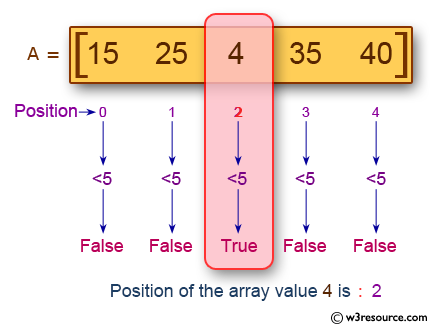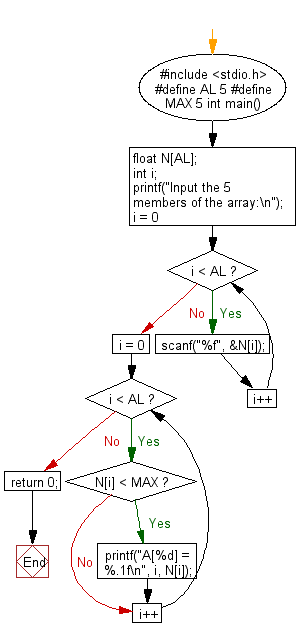C Exercises: Print the position and value of an array elements
C Basic Declarations and Expressions: Exercise-50 with Solution
Write a C program to read an array of length 5 and print the position and value of the array elements of value less than 5.
Pictorial Presentation:

Sample Solution:
C Code:
#include <stdio.h>
#define AL 5
#define MAX 5
int main() {
float N[AL];
int i;
printf("Input the 5 members of the array:\n");
for(i = 0; i < AL; i++) {
scanf("%f", &N[i]);
}
for(i = 0; i < AL; i++) {
if(N[i] < MAX) {
printf("A[%d] = %.1f\n", i, N[i]);
}
}
return 0;
}
Sample Output:
Input the 5 members of the array: 15 25 4 35 40 A[2] = 4.0
Flowchart:

C programming Code Editor:
Contribute your code and comments through Disqus.
Previous: Write a C program to read and print the elements of an array of length 7, before print, put the triple of the previous position starting from the second position of the array.
Next: Write a C program to read an array of length 6, change the first element by the last, the second element by the fifth and the third element by the fourth. Print the elements of the modified array.
What is the difficulty level of this exercise?
Test your Programming skills with w3resource's quiz.
C Programming: Tips of the Day
Static variable inside of a function in C
The scope of variable is where the variable name can be seen. Here, x is visible only inside function foo().
The lifetime of a variable is the period over which it exists. If x were defined without the keyword static, the lifetime would be from the entry into foo() to the return from foo(); so it would be re-initialized to 5 on every call.
The keyword static acts to extend the lifetime of a variable to the lifetime of the programme; e.g. initialization occurs once and once only and then the variable retains its value - whatever it has come to be - over all future calls to foo().
Ref : https://bit.ly/3fOq7XP
- New Content published on w3resource:
- HTML-CSS Practical: Exercises, Practice, Solution
- Java Regular Expression: Exercises, Practice, Solution
- Scala Programming Exercises, Practice, Solution
- Python Itertools exercises
- Python Numpy exercises
- Python GeoPy Package exercises
- Python Pandas exercises
- Python nltk exercises
- Python BeautifulSoup exercises
- Form Template
- Composer - PHP Package Manager
- PHPUnit - PHP Testing
- Laravel - PHP Framework
- Angular - JavaScript Framework
- Vue - JavaScript Framework
- Jest - JavaScript Testing Framework
